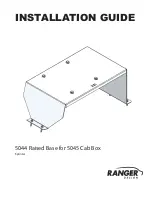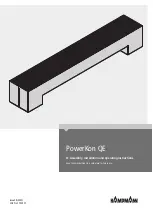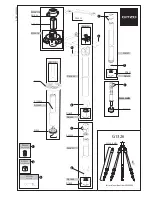
GuiLin FeiYu Electronic Technology Co., Ltd http://www.feiyudz.cn E-mail:[email protected]
GuiLin FeiYu Electronic Technology Co., Ltd http://www.feiyudz.cn E-mail:[email protected] Page 2
resetting
and initialization is recommended:
1.
The device has not been used for a long time.
2.
There is a change in environmental temperature of over 30 degrees.
3.
When in
Auto Balance Mode
, and the installed device in the horizontal position, the plane
control surfaces begin to move and deflect by itself, without input from the pilot.
Initialization / Reset Procedure
Install the jumper as shown in this picture:
Power-ON the FY-20A and keep it stationary for at least 20
seconds. You will notice the red light blink with two different rates.
After 20 seconds the re-setting / initialization is complete.
Disconnect the power, unplug the jumper and remove (keep it in a
safe place for future use).
NOTE:
•
Carry out this re-setting procedure only if the three conditions (above) occur.
We do not
recommend regular scheduled re-setting.
It is NOT necessary and NOT recommended.
•
The stabilizer unit does not need to be in a horizontal position during initialization. However,
you must ensure there is no vibration during this process. If you suspect shaking had occurred,
just restart the initialization / resetting process.
Electrical Connection and Diagram
a)
FY-20A Power
•
The FY-20A operates between 4 to 6 volts input.
•
FY-20A is powered via the Receiver connection.
•
If your plane is electric powered, the Receiver power supply is normally from the ESC.
Alternately, you can supply the Receiver and FY-20A via a separate battery elimination circuit
(BEC).
b)
Connection between the FY-20A and RC Receiver output is via the supplied wire:
FY-20A requires a minimum of 5-channel RC receiver.
c)
3 Receiver channels are used for aileron, elevator and rudder signal output. Connect these 3
receiver output signals to the FY-20A with the supplied wires.
d)
1 Receiver channel is required to control the FY-20A working mode via a 3-position switch.
e)
Example Minimum 5 channel receiver:
Channel 1
= Aileron Signal Output
Channel 2
= Elevator Signal Output
Channel 3
= Throttle Signal Output
Channel 4
= Rudder Signal Output,
Channel 5
= Switch channel with 3-position switch to control FY-20A working modes.
Connection Warning
Be very careful when you are plugging in your servos / connectors. Wrong installation can result in
damage to your power supply or your Receiver.
Double check your installation and ensure ALL connectors are plugged in correctly. Example of
wrong
installation
:
Plane Connection Layout:
1)
Normal / Traditional servo layout:
Servo 1
Servo 2
Servo 3
Aileron
servo
Elevator
servo
Rudder
servo
2)
Plane without aileron servo:
Servo 1
Servo 2
Servo 3
Rudder
servo
Elevator
servo
Don't
connect
3)
Delta-winged plane servo:
Servo 1
Servo 2
Servo 3
Differential
servo 1
Differential
servo 2
Rudder
servo
For all fix wing aircrafts (including the traditional rudder, aileron and elevator planes, and planes with
aileron and elevator mixing, and so on) if the rudder is NOT used in any mixing function, you can have
two options ,as shown below:
1.
Keep the FY20A rudder channel (RUD IN, RUD OUT) open (not used). Connect the Rudder servo
directly to your RC Receiver.
2.
Connect your Receiver Channel 4 to FY20A (RUD IN) and
connect the rudder servo to RUD OUT.
Aileron-Elevator Mixing
For the following aircraft: Delta Wing with Elevator signal mixing
(e.g. Flying wing Elevon):
Differential Output is carried out by using a jumper as shown here. The jumper has to be installed
before powering ON. If you install it after powering ON, the mixing function will not take effect.
Do not remove this jumper. Leave it installed as long as you are using the mixing function.
Rudder-Elevator Mixing
The Jumper should NOT BE USED if you want to do Rudder-Elevator Mixing, because FY-20A does
not support Differential-Mode stabilization for rudder-elevator mixing.
Therefore, the rudder-elevator differential control for V-tailed planes must have an add-on mixing
device for the corresponding differential channel before connection to the servos:
VIBRATION CONTROL
a)
The FSS in the FY-20A is vibration-sensitive. To optimize its stabilization capability, vibrations
reaching the unit must be kept at a minimum.
b)
Therefore when installing this flight stabilizer, we highly recommend that you install it with the
supplied shock absorbing platform.
c)
The algorithm in the FY-20A compensates for normal levels of flight vibration. However, if the
vibration experienced by the unit exceeds the acceptable level, it will NOT work normally or may
even stop working altogether.
d)
To keep vibration at a minimum, install the FY-20A away from the engine or any other vibration
sources.
e)
The included shock-absorbing mount will meet the damping requirements of electric powered
aircrafts and most gas / nitro planes.
f)
If you receive your shock absorbing mount uninstalled (A), assemble it as shown below (B):
g)
Use the supplied Velcro strips to mount the FY-20A to the
suspended platform.
h)
Mount the entire unit to the plane using double sided tape
(recommended), Velcro, screws or glue.
Only the vibration damping pad is enough when the vibration is not
so big.
The supplied Damper Mount will take care of most aircraft
vibrations, unless it is (the vibration) too severe.
WARNING
: VIBRATION CHECK
Even with the shock absorbing mount, your aircraft installation may not meet the damping
requirements of the FSS. To confirm correct vibration damping, please follow this procedure:
A.
After connecting all wires between the Receiver, FY-20A and Servos, install the unit as
recommended (ensure correct orientation).
B.
Run the plane engine or motor at different throttle levels.
DO NOT TAKE OFF
.
C.
Move the throttle level to different positions and maintain it for 20 seconds at each position.
D.
At each throttle position, observe the state of the red and blue lights flashing from the FY-20A.
E.
If the red and blue lights both stay
ON solid
, then the vibration dampening is not enough. You
will need to add additional dampening support or change the installation location.
F.
If the red light maintains a steady flashing, and the blue light is OFF, this indicates the vibration
dampening requirements have been met.
FY-20A INSTALLATION: ORIENTATION, POSITION & LEVEL
i.
The FY-20A has an arrow printed on the top of it. Orient the arrow towards the front of the craft
(i.e. direction of flight).
ii.
When installing, please keep the FY-20A horizontal and as close as possible to the "
Centre of
gravity
" (CG) of the aircraft.
iii.
The control benchmark of the FY-20A is its horizontal position. Therefore, ensure the FY-20A is
in the horizontal position when the plane is in level flight.
iv.
If there is deviation between the FY-20A horizontal position and the plane
’
s level flight, it may
cause the neutral value to be different between the
Manual Mode
and the auto
Balance Mode
.
This difference may result in the following:
FY-20A Pre-Flight Checking and Debugging
PRE-FLIGHT CHECK
:
The following procedure explains how to check for correct servo control direction upon FY-20A
activation. You should also check that the FY-20A does not control the aircraft servos when in Mode 1
(Deactivated Mode).
STEP 1: DIAL ADJUSTMENT
Adjust the three dials on the FY-20A so that the arrow is in the middle, as shown below. Then
rotate all dials in one direction (does not matter which direction):
Servo (blue arrow) is plugged wrongly
resulting in the signal wire (white) missing
the FY20A signal pin.
This results in the incoming power cable
(RED) and servo wire (BLACK) short
circuiting (red arrows).
This will short circuit your battery or BEC!
DOUBLE CHECK YOUR
INSTALLATION BEFORE FIRST
TIME POWERING UP!
A
B
v. We do not recommend using
your transmitter trims to level
your aircraft in Auto Balance
mode, as the new trim settings
will affect your aircraft when you
revert to Manual Mode. It is best
to land and adjust the FY-20A
installation.





















